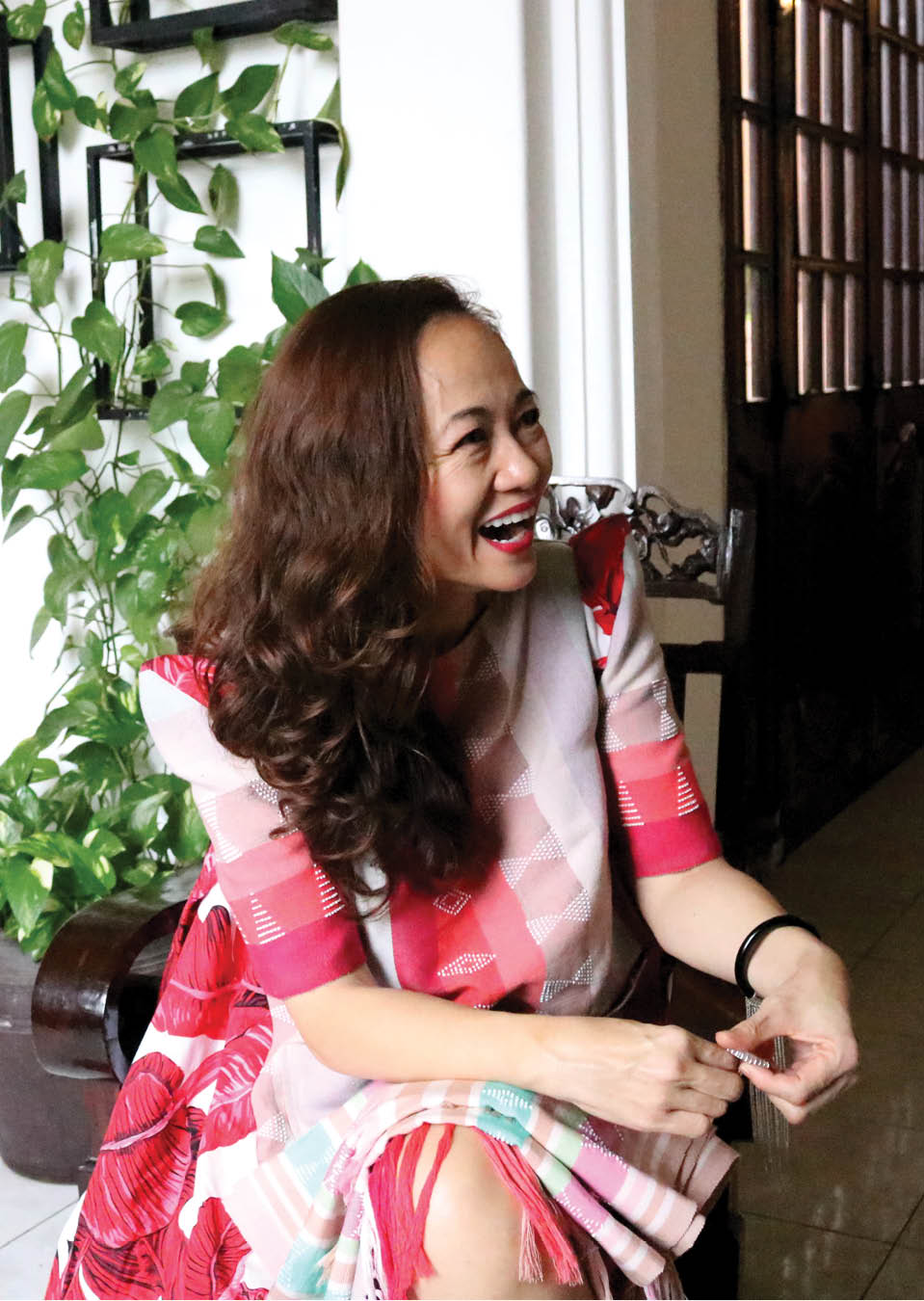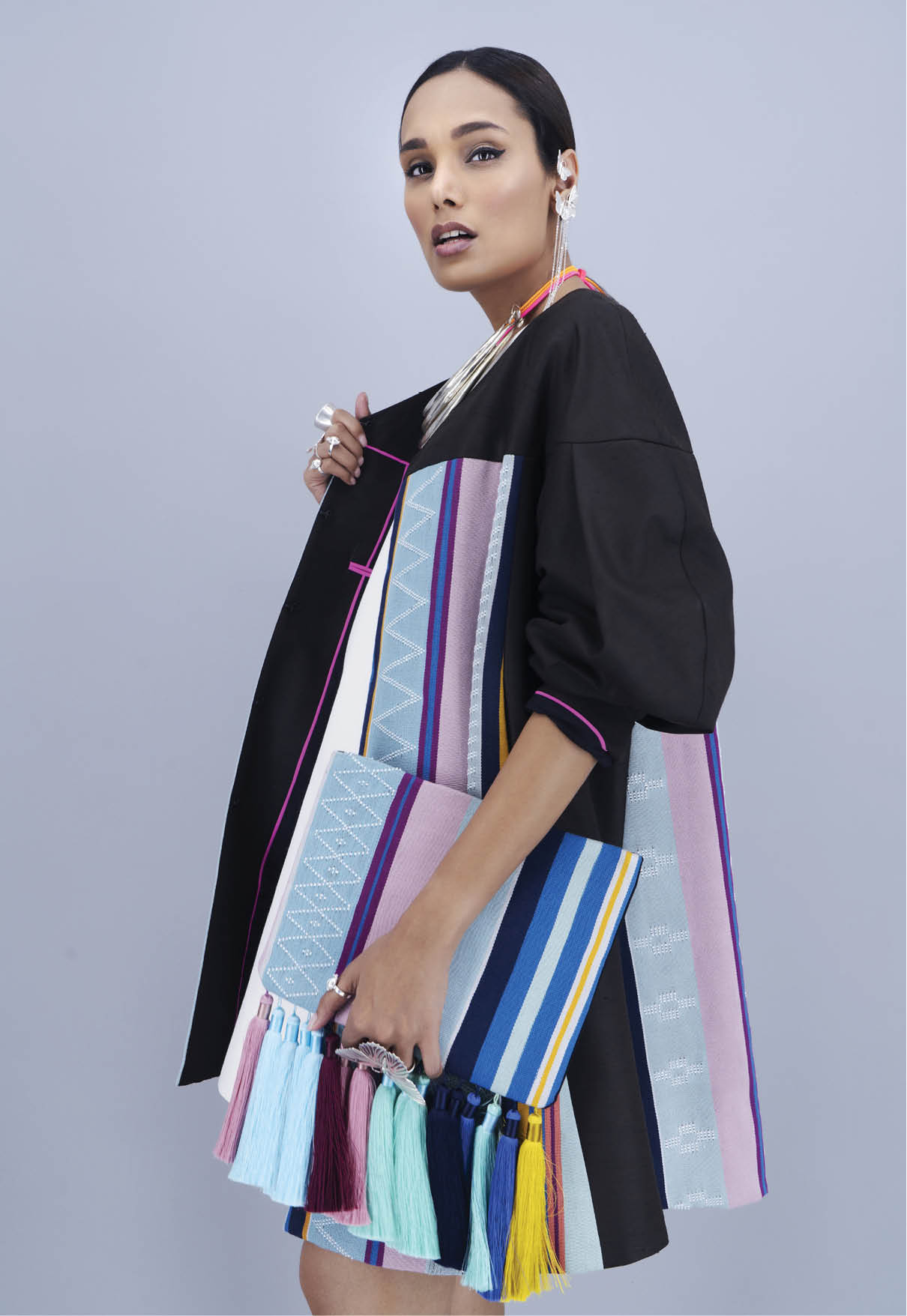
Lan Vy Nguyen is in her own designed clothes from zeng in all her business meetings and events
Recycled materials to become artifacts
In the ceremony of the 30th anniversary of Coats Phong Phu Ltd., the company director William Harold Watson III excitedly introduced two guests on stage Lan Vy Nguyen and Le Thi Chau Quynh from F4F – a social enterprise.
He said that they have helped in making artistic woven fabrics of zeng from a large amount of extra thread (the high-quality yarn left after the orders were fulfilled and those used as samples for new orders).
In order to have this cooperation, Lan Vy Nguyen spent four years selecting colors, designing samples and convincing the business partner and even getting support from an organization of the provincial Union of Science and Technology Associations. Beyond the traditional colors, red and black, zeng weavers in A Luoi now have more materials and new designs to provide for F4F to design fashion items.
Coats Phong Phu provides zeng weaving cooperatives in their project in A Luoi with more than 600 kilos of thread every month. Ho Thi Tha, a member of Nham cooperative said: “I make two or three zeng cloths of 0.7 x 3 meters. The new materials help make the product good-looking and cool to wear. Local people have bought zeng to make shawls, ao dai and waistcoats.
F4F’s items made from zeng and other handicraft materials are priced at a few hundred dollars each on the European market. At the glance of the photos of fashion samples Victoria Ho presented in her PhD thesis, it is a big surprise to know that they were made from zeng woven by Ta Oi ethnic group in A Luoi.
Lan Vy Nguyen said that the designs by herself and Victoria Ho made a name for zeng and it has become one of the favorites of the foreign idiosyncratic clients.
In addition, F4F has formed a line of jewelry from discarded computer components, including fancy-designed bracelets, necklaces and earrings. The F4F designs are finely crafted by artisans throughout the country and the process of selecting recycled materials is supervised by a specialist to ensure transparency and product quality.
“Some items were ordered as gifts to VIP clients such as Lexus Vietnam, Coats Phong Phu Ltd., and others in the UK, the US and Canada,” said Lan Vy Nguyen.

A model in fashion items made from zeng and jewelry made from recycled valuable metals
Think green, do green
Lan Vy explained to me the choice of F4F: “Naturally, fashion is constantly changing, but green fashion is persistent and ethical.” And thus, it is very hard for the manager to find skillful artisans, to supervise the production closely and to convince the customers of the higher price. Although F4F fashion is for a particular group of customers, it has had a strong vitality for the past few years. Once using the good, customers often introduce the product to more customers who are well-known celebrities and businesspeople.
According to Pham Thi Thuy Hang, M.A, lecturer of fashion design at the Department of Applied Fine Art, the University of Fine Art, Hue University, this fashion line has applied the 3R principles (reduce, reuse and recycle) in addition to its aesthetics.
This has added new value to zeng, as well as other handmade beautiful jewelry made from valuable metals in discarded components of computers and phones, that satisfy the needs of domestic and foreign customers.
The ethic in fashion is also a consideration for designers in the sense that they have a proper calculation so that they won’t cut the beaded pattern on the zeng cloth. “It is a life story that the weaver tells through the cloth pattern and, of course, we can’t interrupt their story.” “It is impossible to have a zeng cloth wider breadth as customers want, because the weavers stretch the fabric with their feet and do it entirely by hand.”
Lan Vy’s responses in both English and Vietnamese to customers and workers tell me a truth that it is not simple to stick to the principles of this fashion line.

Coats Phong Phu’s zeng woven from threads
Le Thi Chau Quynh, co-founder and executive of F4F in Hue, said that many businesses offered the cooperation with us, but then they said we were very demanding.
“In F4F, the artisans are the most important. If the design is rigidly followed and repeatedly fixed and intervened, it will be wasteful and no longer ‘green’. The Chief Creative Officer, Victoria Ho, was very strict at first, but then she realized the importance of the creative artisans. This is the point she is making in her PhD thesis,” Chau Quynh added.
Vietnamese think “Goodness is better than beauty” as goes a saying and Western people suppose “Beauty is only skin deep.” F4F fashion has a hidden charm that its partners often exclaim: “Wow, it’s fantastic!” when they are told about its story. Presumably, its story accounts for the way customers specially spread F4F branding, making Vietnam known as a cradle of a green fashion line that catches the future trend.
“I have been to many countries where the way F4F helps to keep the jobs of ethnic minorities, develop zeng and honor artisans have been appreciated. I am invited to share the experience to help them have proper methods to preserve the Navajo culture in Arizona, USA. This will be a pride and honor as I feel that Vietnam also has something worthwhile for international friends to learn. My goal in the near future is to make zeng an item in the Victoria Albert Museum (London) together with dragon shoes and Hue embroidery art on lacquer silk,” said Lan Vy Nguyen.
Story: Tue Ninh
Photos: Phuong Thao – Victoria Ho